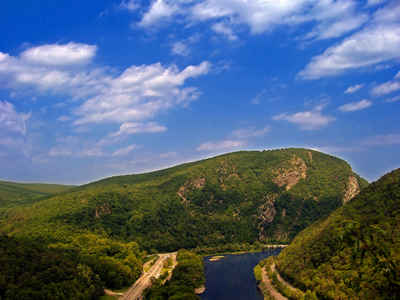Delaware Counties
Delaware has three counties: New Castle, Kent, and Sussex, the fewest Counties of any US state. The origin of the county boundaries go back to former court districts. The powers of the counties' legislative bodies are limited to issues such as zoning and development.Delaware Counties: History and Information
Find a brief history of Delaware Counties
Delaware's history is a long and proud one. Early explorations of our coastline were made by the Spaniards and Portuguese in the sixteenth century, by Henry Hudson in 1609 under the auspices of the Dutch, by Samuel Argall in 1610, by Cornelius May in 1613, and by Cornelius Hendricksen in 1614.
During a storm, Argall was blown off course and sailed into a strange bay which he named in honor of his governor. It is doubtful that Lord De La Warr ever saw, or explored, the bay, river, and state which today bears his name. In 1631, 11 years after the landing of the English pilgrims at Plymouth, Massachusetts, the first white settlement was made on Delaware soil.
A group of Dutchmen formed a trading company headed by Captain David Pietersen de Vries for the purpose of enriching themselves from the New World. The expedition of about 30 individuals sailed from the town of Hoorn under the leadership of Captain Peter Heyes in the ship De Walvis (The Whale). Their settlement, called Zwaanendael, meaning valley of swans, was located near the present town of Lewes on the west bank of the Lewes Creek, today the Lewes and Rehoboth Canal.
Following the English conquest of 1664, all of the land on the western side of the Delaware River and Delaware Bay was governed as part of the
New York Colony and administered from the town of New Castle. During the brief recapture of the colony by the Dutch in 1673, additional court
districts were created around Upland and Whorekill. The latter was also known as Hoornkill, and is now the town of Lewes. The court at New Castle
was left with the central portion of the colony. The jurisdiction left to the court at became New Castle County, and the county seat remained at
New Castle until 1881 when it was moved to Wilmington. In 1680, Whorekill District was divided into Deale County and St. Jones County. After this
division, Lewes became the county seat of Deale, which was later renamed Sussex County. The former Upland District was named after the New Sweden
settlement of Upland, and was renamed Chester County in 1682. Chester County is now located within the present boundaries of Pennsylvania.
Lord Baltimore, the Proprietor of Maryland, claimed all present-day Delaware, and organized its northern and eastern portions as Durham County,
Maryland. However, this county existed only on paper. The southern and western portions of present-day Sussex County were organized as portions of
several adjacent Maryland counties and were not recognized as part of Delaware until the Mason-Dixon Survey was run in 1767. In 1791, with the
expansion of Sussex County to the south and west, the county seat was moved to Georgetown. The county seat of St. Jones (renamed Kent County in
1681) is at Dover.
Find a brief history of Delaware Counties |
||||
|---|---|---|---|---|
| County | 2000 Population |
Square Miles |
County Seat | Created |
| Kent County | 126,697 | 591 | Dover | 1680 |
| New Castle County | 500,265 | 426 | Wilmington | 1673 |
| Sussex County | 156,638 | 938 | Georgetown | 1680 |






